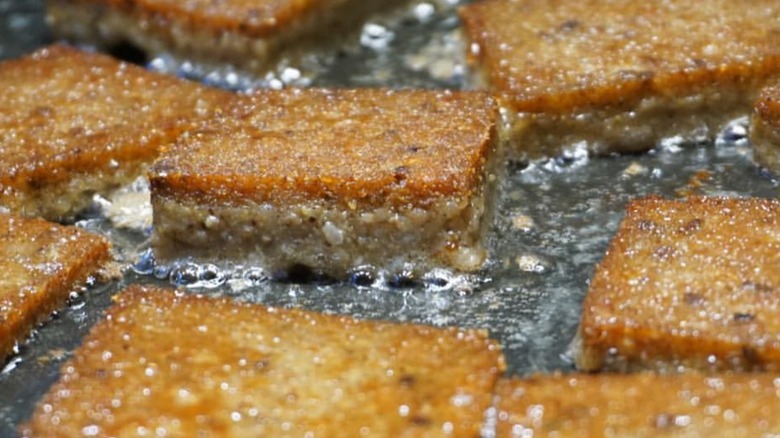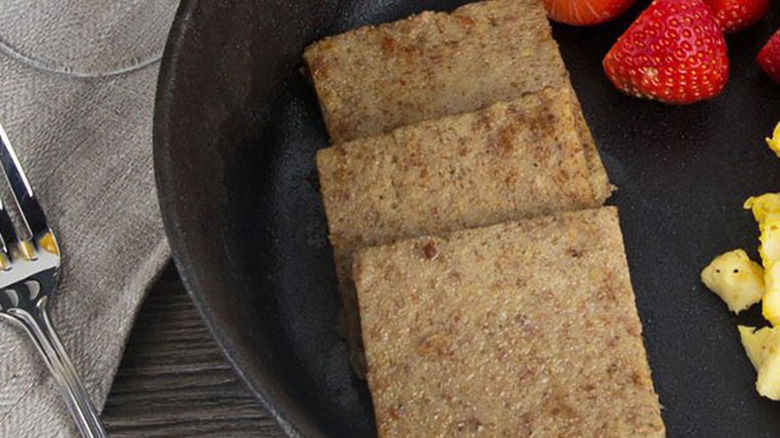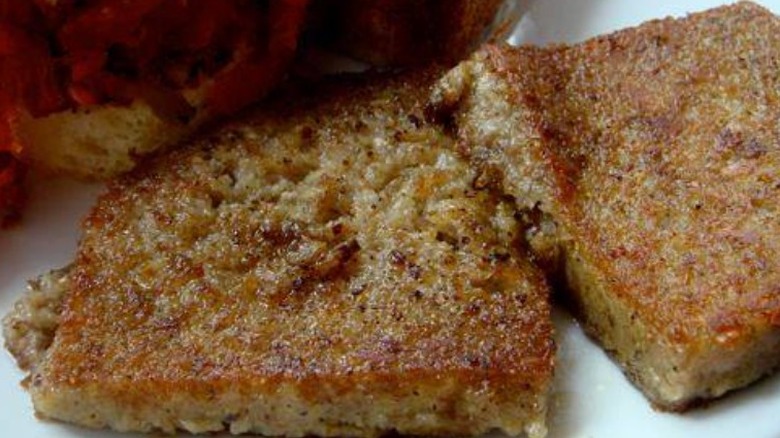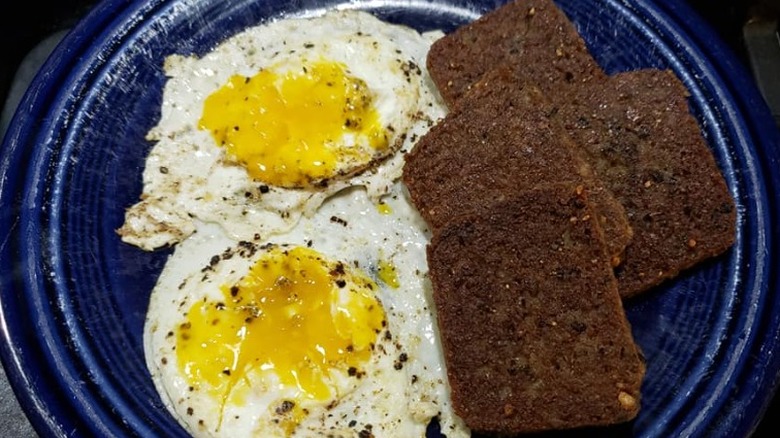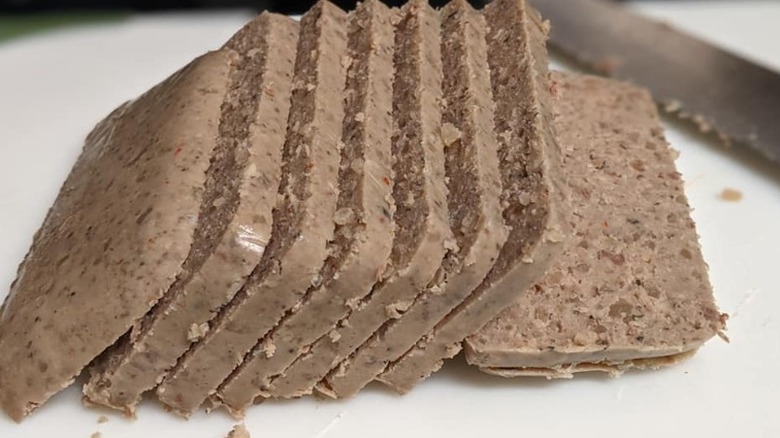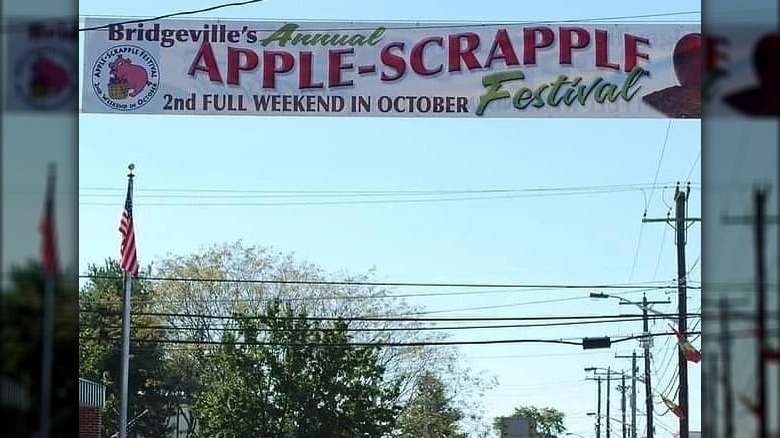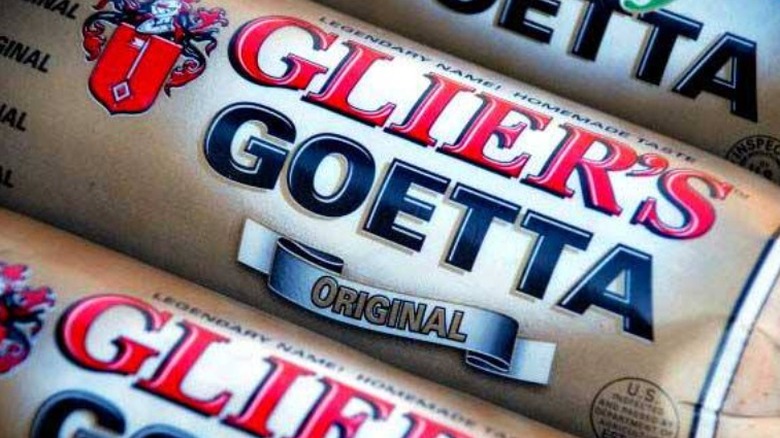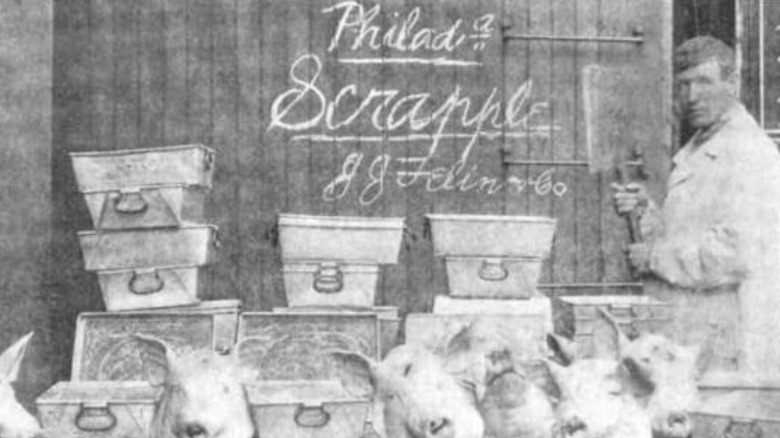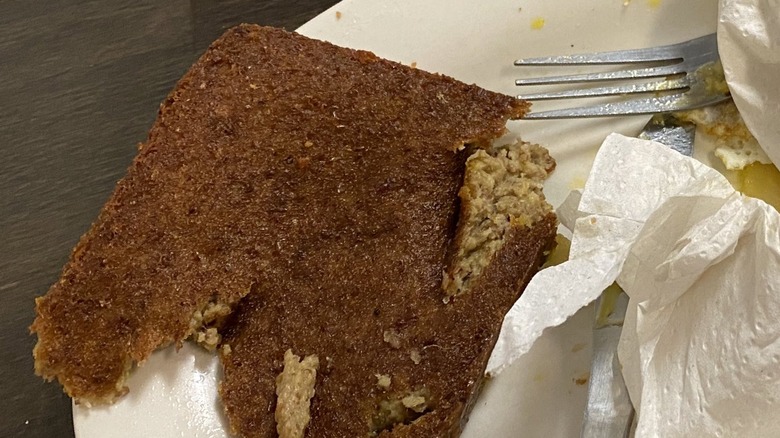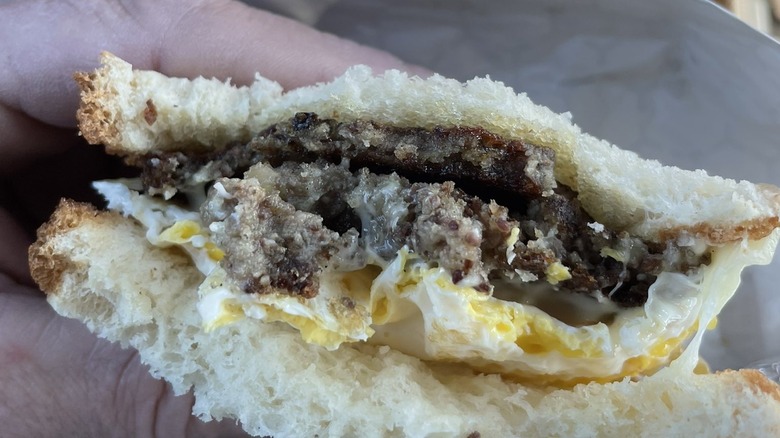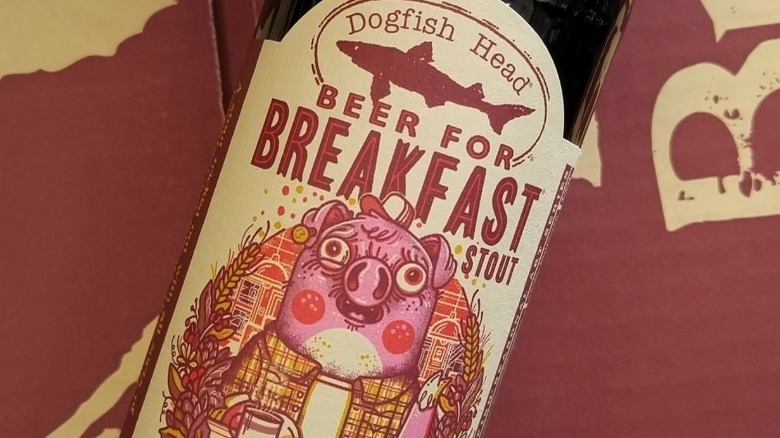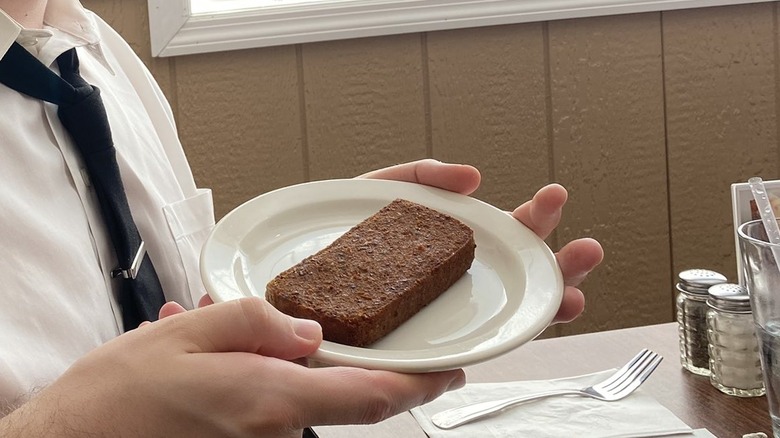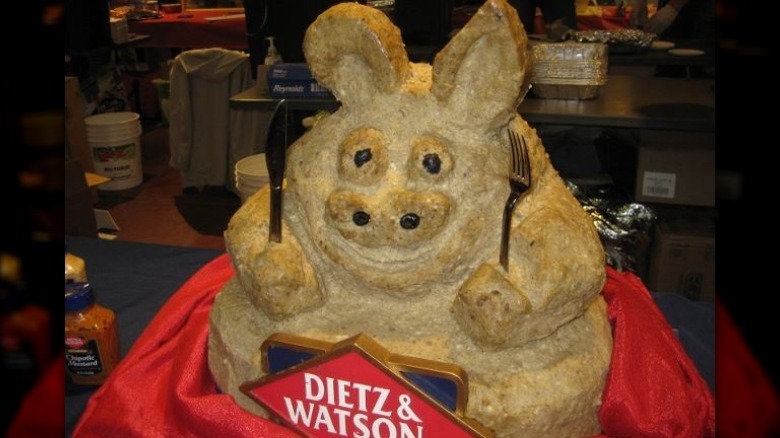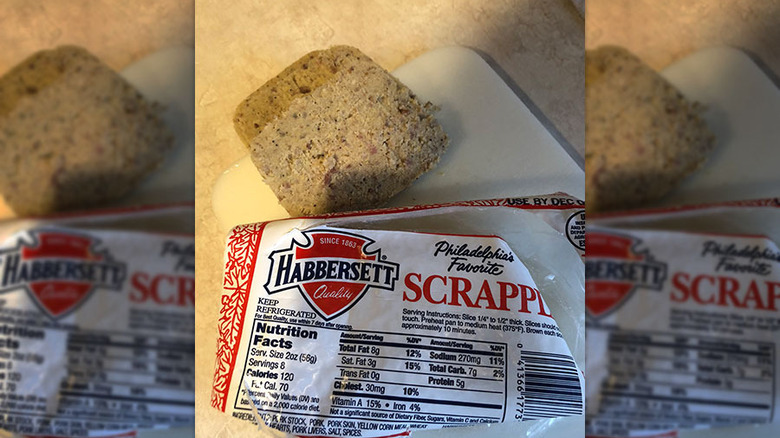The Untold Truth Of Scrapple
At one point in food history, if you weren't from the North Atlantic states then you'd probably never heard of scrapple. But good news travels fas these days. Scrapple is a regional food that's been known to elicit international reactions. Hailing from the Delaware Valley (per Delmarva Now), this pan-seared breakfast meat is served sizzling, often with a side of fiery opinions and hot takes. Some people love it and are happy to have it on their plate every morning. Others think that it has a better place on Andrew Zimmerman's "Bizarre Foods." No matter where your love falls on the scale, the untold truth of scrapple is something we can all sink our teeth into.
As a local tradition from the country's oldest states, scrapple has a rich origin that ties tightly with the history of the United States. Americans have added their own additions to scrapple over the centuries, but it's not a dish that belongs purely to this continent. Along its long and winding path, scrapple has been at the center of heated debate — a driving force in the reemergence of nose-to-tail cooking and a cause for celebration. So, pull up a seat at the breakfast table because there is a lot about scrapple to fill yourself with.
The origin of scrapple's name
Scrapple haters will often argue that an enigmatic composition means this breakfast meat is not to be trusted. Beyond a mystery makeup, the nomenclature of scrapple is also a case of mistaken identity. In actuality, the word scrapple itself comes from a pretty direct origin. As The Encyclopedia of Philadelphia reports, scrapple is a term that derived when the English encountered the Pennsylvania Dutch food pan haas. Pan haas is a German word used to describe "pan rabbit," or rabbit that has been pan-fried (a similar cooking method to modern scrapple). National Days Today writes further that panhaskroppel is the complete German term for "pan rabbit" and skroppel ("a slice of"). The connection between the words skroppel and scrapple are only a few letters apart and clear to connect.
Pan haas (or pan has) rings like a Germanic word, but The Encyclopedia of Philadelphia writes that the creation of scrapple is attributed to the Pennsylvania Dutch. So, which group is the one that brought this succulent foodstuff to our plates? You might think the naming rights to scrapple would be contested between several proud populations. But if you're from Atlantic Coast states, then you probably know that the Pennsylvania Dutch and German peoples are actually one and the same. Despite being mistakenly called Dutch, it was German immigrants who first began sizzling scrapple on the shores of America.
How scrapple came to be
Recognizing that the Pennsylvania Dutch are German peoples means that Northern and Western Europeans can comfortably consider themselves inspirational to the development of scrapple as we know it. Per reporting in The Morning Call, even the word pan has is a descendent of the Celtic panna. So as history would have it, ancient Gauls had a tradition of cooking foods closely related to scrapple long before the meat arrived in America. The morning Call reports that variations of scrapple span across the European continent. Exceptionally tasty treats are known to spread.
As for American scrapple, you only have to trace the expansion of the Pennsyvlania Dutch across the continent to see how it expanded on our tastebuds. Various chronologies from regional newspapers like Reading Eagle describe how the Dutch arrived in Pennsylvania to flee from persecution (although scrapple still faces some bullying). These German migrants settled around the Philadelphia area before moving slowly southward to Delaware and Maryland, as well as westward into Ohio. They carried their food traditions with them, making it no coincidence that these states are now proud scrapple strongholds.
Scrapple was once considered healthy
It's easier to know where scrapple comes from than it is to know what it is actually made of. Secret formula aside, Taste Cooking writes that there is a general lineup of ingredients that are often included in scrapple, such as pork kidney and heart. Some of these offer nutritional value, others are more fillers than fundamental health foods. Scrapple starts with pork trimmings (or, scraps) and features spices along with binding ingredients. Other additions, like liver, have known health benefits such as offering heavy doses of natural vitamins.
Inclusion of offal aside, eating crispy, greasy, fried meats for breakfast every morning doesn't really constitute a balanced and healthy diet these days. At some point in the history of scrapple, however, it did. Jacques Kelly reports for The Baltimore Sun that in 1906, the newspaper published an opinion that referred to scrapple as the "king-victual and master-aliment" of those who ate it. In 1909, The Montreal Gazette wrote that "scrapple-fed children in the country are healthier and make more progress at school," while a man who filled up on scrapple could be relied on to do more hard labor than any others. The secret component that gave scrapple its consideration of "healthy food" is one that Americans know well: cornmeal.
The American melting pot holds it all together
The Montreal Gazette had some harsh words for scrapple itself (saying people "pretend to enjoy" it), despite glowing comments about the benefits that consuming it delivers. In particular, the Gazette claimed that men who ate scrapple could go out on the coldest days and "laugh at the winds," thanks to the key, heat-making ingredient of cornmeal. Food writers for The Washington Post detail how cornmeal is one of America's oldest food traditions as it was given to settlers by indigenous populations. Taste Cooking writes that it wasn't known for use in scrapple until Europeans reached the American continent.
The Encyclopedia of Philadelphia states that before bringing scrapple to North America, Europeans instead employed a different, native ingredient to bind their pan has. Before they were the Pennsylvania Dutch, German cooks used buckwheat flour as the choice component to hold their pan has together. Cornmeal was not yet available. However, they shared this beloved breakfast food with English settlers, who likely would have introduced them to the cornmeal they had received from indigenous peoples. The bond was between the two foodstuffs remains to this day. While it is still possible to find scrapple that's held together with buckwheat, cornmeal binding is the general rule when it comes to making scrapple.
There's a National Scrapple Day (and festival)
Scrapple is a regional food through-and-through, so it isn't as widely known in some areas of the country as it is for people in the Northeast Atlantic. But, localized as it may be, scrapple is an earnest part of the American food culture. So rather than seeing it as something confined in availability to a small segment of states, scrapple should be celebrated for its specificity. And it is! Farmer's Almanac lists November 9th as National Scrapple Day.
There is no better time to rejoice in the crispy crust of pan-fried scrapple than the chilly days of late Autumn. Philadelphians often claim their city as being the birthplace of scrapple, but Delaware finds a way to honor the dish in bigger ways during the peak season. The Apple-Scrapple Festival takes place during the middle of October in Bridgeville, and it is one of the hottest parties in town when it comes to eating up a sizzling slice of breakfast meat. There are fun art contests, eating competitions, and everything else you can hope for within a food celebration.
You can find versions of scrapple under different names
What's in a name? The smell of scrapple by any other is just as savory. Although time has made the modern-day moniker for this meat-stuff from a line long of ancestors, there are many other ways to identify it. As The Takeout writes, residents of states like New York, Delaware, and Pennsylvania, can be picky about their scrapple. They may even think that their scrapple is one of a kind. But plates of similar-looking dishes are actually served up and down the Atlantic Coast. As it turns out, scrapple has a family tree the size of a country.
The key components of scrapple are not that exclusive to the dish: Combining ground meat, grains, and spices together in a slice of sizzling breakfast meat is something you can find cooks doing in Cincinnati, for example. There, the dish is called goetta, and as the city of Cincinnati specifies, oats are the specific ingredient that separates their local delicacy from its eastern cousin. You can find another relative to scrapple in the lower latitudes of the U.S. too. Southern Living writes that in North Carolina it is called livermush. As the name suggests, the composition is more liver than ground meat, but the golden texture of a cooked slice is very similar to scrapple.
Scrapple may have helped inspire Labor Day
Early 20th century reporters from Baltimore and Montreal may have touted scrapple as a man's fuel to work harder, but What Is Scrapple! reports that some researchers have actually tied a love of this punky pork product to a special day of rest. That's right, scrapple may have played a unique part in securing one of the biggest wins for the early Labor Rights movement in America. If you're ever wondering which motivated activist to thank for coming up with the national holiday known as Labor Day, add one Rasher Liverburg to that list.
What Is Scrapple! claims that recent historical discoveries by the Research Association of Pork Amalgamations suggest that Liverburg was one of the first workers to propose an annual day off of work. The conveniently-named laborer was a liver-shoveler for Panhas Packaging, a regional distributor of scrapple. As the story goes, Liverburg was distraught that he should work all day without ever getting to enjoy the meaty fruits of his labor. So, he suggested an "Enjoy Your Scrapple Labor Day" to warehouse management. He proposed that the factory should get a day off in which everyone gets to enjoy a brick of breakfast meat. As What is Scrapple! summarizes, eventually the word "labor day" made it to the heavier-hitting unions in New York City, inspiring a workers' revolution.
Catching feels for scrapple? It's probably the texture
If scrapple is powerful enough to create a nationwide labor movement, what else can it do? Maybe the question we should be asking is this: What is it that makes scrapple so beloved? USA Today has an answer. In her reporting for the newspaper, native Philadelphian Kae Lani Palmisano writes that a heartfelt dedication to scrapple may end with flavor, but it starts with the texture. According to someone who grew up on the stuff, a searing skillet is where real scrapple separates itself from lesser breakfast meats.
From personal experience, crispy bacon is best but it can be hard to find restaurants that cook it in a consistent way. When sausage is grilled as crispy as scrapple, it can end with a bite into a dried-out center that needs some sauce (or egg yolk). That's where the love of this Northeast best breakfast food comes in. Hot scrapple has a crust that crunches even when layered between bread and fried eggs. The hot oil that bubbles to the surfaces rushes your mouth with salty goodness, and the scent that rises from a fried slice immediately invokes the sensation of crumbly pieces. When it comes to scrapple, the texture is the truest form of flattery.
Scrapple was an early food debate
We all know of or have been a part of a verbal food fight. You say this particular dish is tasty, and your friends say that you have no tastebuds. Discourse about the merits of one dish over another have been a long-standing tradition since before the term "foodie" was coined. So long-standing actually, that in 1872, food lovers were posting letters to The New York Times to pick fights with each other over a certain provocative delicacy found on the Atlantic coast region.
The Great Scrapple Correspondence is a little-known battle of food culture that occurred for better reasons than many wars have started over. It began when one correspondent, named EPICURE, wrote into the paper with a recipe for his wife's scrapple. What happened next is recorded as a "slow motion" version of the type of social media threads we see today. Some letters arrived in defense for the delectable meat. Others offered recipe suggestions for substitute ingredients. Many more piled for a complete attack on scrapple's integrity.
In the end, it was a 19th-century scrapple-hater who had the last word. They wrote an opinion suggesting that meat left on the roof in a rainstorm would be more appetizing than eating pan has. Not surprisingly, they penned in with the name ANTI-SCRAPPLE.
Eating it isn't the only thing scrapple is good for
Texture and taste are what traditional scrapple lovers fall for, but foodies and epicureans are always looking for new takes on old eats. It was only a matter of time before scrapple came up for consideration. Honestly, after being in the public eye since before 1872, it's surprising that it took food and beverages makers this long to set their sights on scrapple. But they have, and now it has become much more than breakfast food.
Per Mental Floss, in 2014 Delaware-based brewery Dogfish Head decided to take on a new approach to the world of breakfast beer. In conjunction with regional producer Rapa Scrapple, the craft brewery created a drink known as "Beer for Breakfast." It is both inspired by and utilizes scrapple as an ingredient. Delaware Online reports the beer became so popular that Dogfish Head decided in 2017 to bottle it as a seasonal. Dogfish Head isn't the only booze-maker to try a scrapple-flavored something. Barstool Sports writes that Painted Stave Distilling (another Delaware company) has been making a scrapple-flavored vodka since 2015.
Scrapple is only getting more popular
It is easy to pick on people who take food seriously, and it's even easier to laugh at seemingly ridiculous (or gross) cuisine concepts like meat-flavored alcohol. However, a food like scrapple deserves our attention and scrapple is now growing in notoriety across the country. But as Amy M. Strauss writes on page 110 of her book, "Pennsylvania Scrapple: A Delectable History," there was a time when scrapple was trendy among foodies before its widespread appeal.
The product has always been thrifty. For much of American history, thrifty hasn't necessarily meant cool. Take slanderers like ANTI-SCRAPPLE and their following, who bully what is an otherwise tasty food that makes use of leftover meat. As more Americans entered middle-class status, however, we began to prefer new luxurious meats like beef over frugal scrap cuts and pork (per Stacker).
Strauss chronicles how a 2014 essay by food writer Josh Ozersky catapulted scrapple back into the American conscious. The gourmet food Renaissance of whole-animal butchering has been fuel for gastronomic projects since the early 2000s. Ozersky's essay detailed the ways that movement directly relates and calls for a renewed interest in scrapple. Further, Penn Live reports, an increasingly broad appeal has made it possible for Facebook projects like The Scrapple Trail to go from 600 likes to nearly over 7,000 active users in less than one year.
For foodies, niche history is the new frontier. For scrapple lovers, we're just glad everyone else is finally coming around.
Waxing poetic about scrapple
Love makes people do whacky things. Apparently, this now includes writing poetry about your favorite meat-made-meal. It isn't enough to simply draft up a poem about scrapple, this snack deserves a whole contest worth of odes. The competition to become the future Shakespeare of scrapple was opened in 2010 at the urging of a blogger from the The Baltimore Sun. The First Annual addition encouraged waxing poets to use difficult words such as "offal, apple, and shrapnel." Such a challenge didn't stop writers from creating epic testaments to their sizzling brown muses.
The website What is Scrapple! recorded a set of poems, specifically haikus that honor the high art of scrapple producing and eating. Poetry writing isn't the only way that artists can display an adoration of scrapple. Remember the Delaware-based Apple-Scrapple festival? The Sun also reports that one of the most popular events of the festival weekend has to do with art. A small, fierce scrapple sculpting contest pits crafters against one another in a bid to become the Michelangelo of a meat mountain.
Cleaning up scrapple's reputation
Giving your affection to scrapple means that you've got to come to terms with its flaws. For some, that hasn't been so easy. In recent decades, The Philadelphia Inquirer has reported how snout-to-tail butchers and chefs have shown immense dedication to scrapple by both selling the once-niche product while also providing education about its traditional roots. Before this whole-animal movement took off, there were some who thought that they should be able to eat scrapple but without the scraps.
In 1987, The Chicago Tribune reported that Philadelphia historian Kenneth Finkel had struck out on a solo crusade to have the most offending ingredients removed from the scrapple-making process. In Finkel's mind, it was the addition of pig snouts that caused an especially severe slight. He argued that Philadelphia meatpackers were exploiting scrapple as a way to get rid of unwanted scraps and in doing so were soiling the centuries of positive history that the food could represent for the city. With a slogan to "Take the scraps out of Scrapple," Finkel went on a tour-de-force of the city, even going so far as to pair with a local chef to create his own scrapple recipe featuring juniper berries and duck in place of snout and other organs. Despite the collaboration, the restaurant where this chef worked never offered to add it to the menu.
